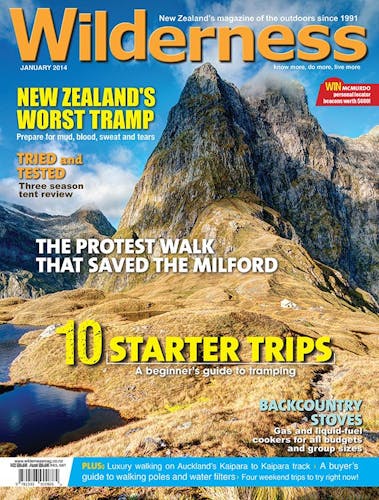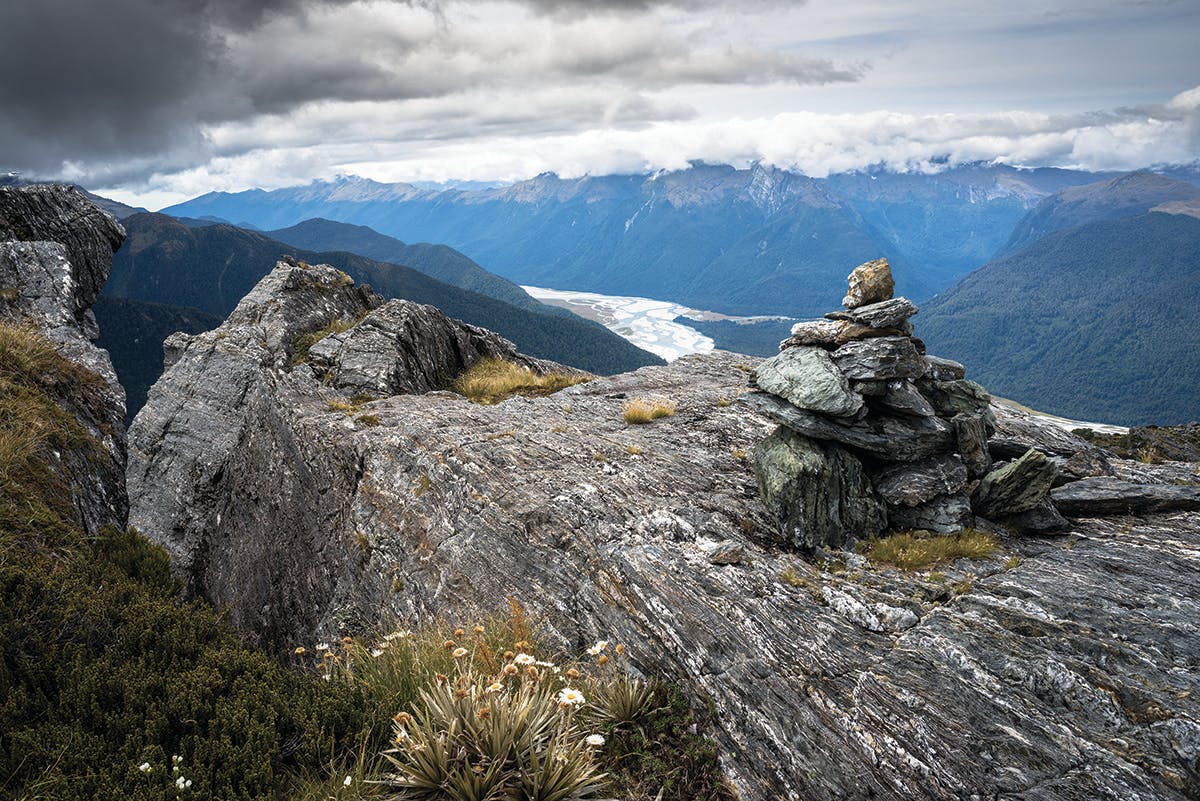These four rock cairns provide a link to the past while serving as a guiding beacon to present-day trampers
As rocks are almost ubiquitous in the mountains, they offer the most natural way of marking routes. On a mountaintop, where a track crosses a river, or across a difficult pass, rock cairns show the way. It’s a Scottish term that derives from the Gaelic ‘càrn’ (plural ‘cairn’) and came to New Zealand with European settlers. Before them, Maori built rock cairns too.
Cairns are used all over the world, and not just in the mountains: coastal ones serve in the waterways of Scandanavia. According to Wikipedia, a German cairn is a ‘steinmann’, and a Dutch one a ‘steenman’, both meaning ‘stone man’. Italian mountaineers use the term ‘ornetto’, meaning ‘small man.’
At its simplest, a cairn is just two stones; placed in such a manner as to ensure it’s recognisable as the work of a human, not some artful arrangement of nature. Most cairns are temporary: rivers bowl them over, avalanches wipe them out, and even wind can obliterate them. Nevertheless, well-built ones in the right location can last for decades. There’s an art to making cairns; the best raw materials include schist, flat plates of which can be stacked into quite durable structures.
Old cairns gather a cloak of lichen or moss, making them blend into their surroundings. But by their height, or unnatural shape, they still serve as route markers. Elaborate ones have many stones, and some grow over the years as people add to them. The largest one I know is that atop Kaweka J, which stands higher than the tallest tramper.
I’ve been grateful for cairns in several situations; none more so than some built by Geoff Spearpoint. I was on a traverse over the Lambert tops, after crossing the Garden of Eden and Allah. Geoff, in the area on a previous tramp, knew of our forthcoming trip and cairned what is a testing piece of country to traverse. It made all the difference for us.
I’ve built cairns for people too. Once, I found out another party intended to follow us over Sunset Saddle (Nelson Lakes National Park), but were nervous about navigating over the route. So my friend Darryn Pegram and I built a trail of cairns for them. Most of mine were pretty perfunctory mounds, but Darryn stacked a couple so high they were visible from more than a kilometre away.
Historic Tokaanu Trail, Tongariro National Park
Early in the 20th century, tourists travelled through Tongariro National Park from Waihohonu to Tokaanu; sometimes on foot, sometimes on horseback. When mist obliterated views, cairns guided them, and some remain to this day. The historic route is now part of the Tongariro Northern Circuit Great Walk.
Kaweka J, Kaweka Forest Park
Kaweka J, at 1924m the highest point in Kaweka Forest Park, is not so much a peak as a broad, featureless ridge. There’s little to suggest its prominence, except for a large pyramid of rocks on the top. Quite probably a cairn existed here prior to 1945, but since then members of the Heretaunga Tramping Club (HTC) have built up this massive one to commemorate trampers who lost their lives in the Second World War. Each November, HTC members trudge up to the summit to hold a service, and add a few more stones to ensure the cairn endures.
Colenso Spur, Ruahine Forest Park
At the base of Colenso Spur, in the Makaroro Valley, is a memorial cairn celebrating missionary explorer William Colenso, who became the first pakeha to cross the Ruahine Range in 1847. Erected by the Royal Society in 1975, the small cairn features rocks cemented into place and an embedded metal plaque.
Charlie Douglas cairn, Mt Ionia, Mt Aspiring National Park
During the filming of the First Crossings TV series over the summer of 2012–13, Rob Brown, Geoff Spearpoint and Mark Watson found what they think is a cairn built by explorers Charlie Douglas and Gerhard Mueller on their 1885 Arawhata Valley exploration. The metre-high stack is on a ridge below Mt Ionia. While it may have been partially rebuilt by later surveyors, chances are this cairn is original and a tangible link with two of New Zealand’s greatest explorers.








